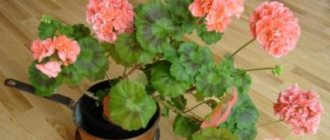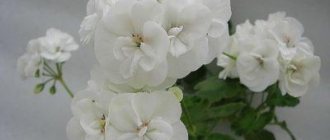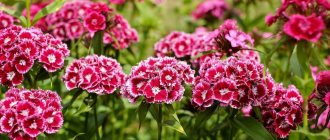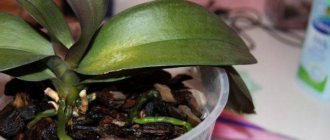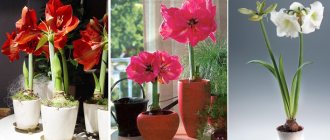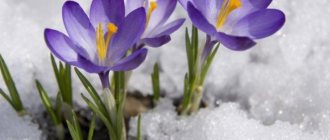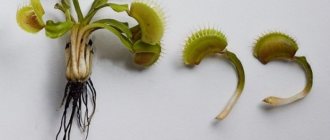When to take Pelargonium outside?
This time occurs differently in each region, but usually geraniums can be planted as early as the first ten days of May. It is at this time that the rhizomes of the plant can warm up to the desired temperature of 15-18 degrees. The timing of flower planting will also be influenced by the choice of planting material.
Interesting materials:
Can stamps be exchanged for money? Is it possible to exchange torn money at Sberbank? Is it possible to exchange an M video certificate for money? Is it possible to exchange an Ozone certificate for money? Is it possible to exchange Soviet money for Russian? Is it possible to draw up a money donation agreement? Is it possible to send money from Tele2 to MTS? Is it possible to transfer money? Is it possible to transfer money from an asset to Beeline? Is it possible to transfer money from Qiwi to Payeer?
A little history and cultivation features
Indoor geranium came to European countries almost 300 years ago from southwest Africa. Over the past centuries, new varieties of geranium have been developed with a variety of bud shapes, leaf colors and inflorescences. They readily decorate not only houses, but also flower beds and flower beds. Geranium can be used to decorate balconies in hanging pots and boxes. The plant has become one of the most popular and beloved.
Of the more than thousands of known varieties of geranium, almost all grow optimally on balconies and loggias. The main thing is to create the conditions necessary for growth and flowering for the plant. Pelargonium is a light-loving plant. It loves the sun, but not its direct hot exposure, but being in partial shade. Tolerates dry air and does not require spraying. The plant feels good at low temperatures. Most suitable conditions: cool nights and warm days. At the same time, the plant gains strength, does not stretch out and always blooms.
To achieve constant flowering, it is important to know one nuance when growing geraniums. The plant stops blooming when it has enough space in the pot. Therefore, it will not require much land. If the roots are tightly and quickly woven into the soil, then the plant will bloom quickly and abundantly. A small pot size is one of the conditions for bright flowering. In large containers, it may not please you with bright inflorescences for a long time and you will have to wait for the roots to fill the voids. Therefore, plant several cuttings at once in large boxes and pots.
READ MORE: Decorating a balcony and loggia for a winter garden
As the geranium grows, the lower leaves may turn yellow. Wait for a couple of new leaves to appear and remove any yellowed leaves. To form a symmetrical and lush bush, you need to pinch the top on the eighth leaf, the shoots can be pinched on the sixth leaf. If the geranium has not yet bloomed, then turn the pot on different sides to the sun so that the shoots grow evenly. When flowering, you should not turn the bush so that it does not stop blooming. Water sparingly as the soil dries out.
First wintering place
On a glazed balcony or loggia. This is how mom arranges her pelargoniums for the winter. But her loggia is warm, even in frosts down to 20 degrees there the temperature is about 5-7 plus, and on average up to 12-15 degrees. Her pelargonium blooms all winter, a little “sparsely” than in summer. In the fall she does corrective pruning. Removes all branches sticking out in the wrong direction. And in March-February he does drastic pruning. He cuts off dried branches almost to the stump, old 2-year-old ones, leaving 10 cm of them. Waters them once every 10-14 days, does not feed with anything. After flowering in winter, pelargonium “falls” into a dormant period in the spring, does not release buds, and the leaves begin to dry out. Kalachik accumulates strength for summer flowering.
Does geranium overwinter in open ground?
In summer, geraniums delight with abundant flowering in the garden. Pelargonium, or geranium, is native to South America. The flower does not tolerate low temperatures well, so it is taken indoors for the winter. We will tell you in this article what subtleties are involved in transplanting geraniums from the garden in the fall.
Features of geranium transplantation
Pelargonium should be transplanted before the thermometer drops below 100C. For central Russia at the end of August - mid-September. Before transplanting, the plant needs to be prepared. Cut off the stalks and dry leaves. Young shoots are suitable for replanting, so it is advisable to remove the old part of the plant. The pot is chosen in such a size that the root system is free, but you should not use too large a container, otherwise the geranium will not bloom.
Preparing the soil for pelargonium
You can buy ready-made soil for pelargonium or mix 2 teaspoons of humus, 1 teaspoon of sand and 1 teaspoon of peat. The root system of the plant can become moldy if you take heavy and stale soil. The plant loves nutritious and loose soil. After replanting, the soil is not compacted; once a month, the top layer is additionally loosened. Geraniums require a high turf layer (minimum 2 cm).
Feeding pelargonium after transplantation
The plant accepts fertilizing with mineral compounds well. At the end of winter they begin to feed with potassium and phosphorus compounds. Nitrogen, on the contrary, reduces. This promotes abundant flowering in spring. Feeding is carried out once a month (in winter and autumn) and once a week (from early spring to late summer). Two weeks before transplantation into the house, feeding is stopped.
Lighting and temperature
Geranium should overwinter at a temperature of 8–10°C, but it tolerates normal room temperature well. You should not place the flower on the south windows. Although the plant loves light, afternoon sun is unacceptable. Twilight will have a detrimental effect on flowering. In spring, geraniums can be transferred to the loggia before planting in the garden.
Humidity and watering
Geranium is moisture-loving. Abundant watering should be done daily. Water for irrigation should be at room temperature.
Humidity in the room is allowed at least 20%. In apartments with a central heating system, the leaves are sprayed once every two days.
Possible mistakes
Pelargonium is an inhospitable plant, but if you make mistakes when caring for it, it will get sick and may die. Let's look at a few of the most common mistakes:
- Overflow. The leaves wish and fall. It is necessary to let the soil in the pot dry, then loosen the top layer.
- The temperature is too low. The edges of the leaves are turning red. Delivering the flower to a warmer room.
- The soil is heavy. The leaf wishes and falls, the root system begins to rot. It is necessary to change the soil.
- The plant is infected with microorganisms. Gray spots appear on the leaves, the trunk dries out. It is necessary to apply fungicides, change or sterilize the soil, and remove the affected leaves.
How to preserve a plant at home and can it be stored in the basement?
Already in the fall, the pot with the plant is placed in a cool and dimly lit place. A southern or northern window sill in a house/apartment is quite suitable for this, since there is diffused sunlight there. And to make up for the lack of light at this time, you can use fluorescent lamps. The optimal daylight hours are 12 hours.
Such lamps are an excellent solution if it is not possible to place geraniums on the windowsill: you can independently build racks with lamps, thanks to which they can be placed anywhere in the house/apartment. Also, additional lighting guarantees the uniform development of all shoots (when there is insufficient lighting, they begin to stretch).
The frequency of watering and the amount of water for this are gradually reduced, because the plant stores water in its thick stems for the winter. You need to water so that the soil is very slightly moist, and the next watering should be done when the substrate is completely dry.
highly not recommended to fertilize geraniums until the very beginning of March. If the plant suddenly begins to wither, you can add fertilizer, but not more than once every month and a half.
It is better to reduce the temperature to 10 - 12 degrees, so for the winter it is convenient to place the flower on the balcony or in the basement. This temperature regime is observed until the beginning of spring.
Important! Do not overwater the plant, especially at low temperatures. It is for this reason that sudden and rapid rotting of roots often begins. The substrate should also not be allowed to dry out excessively. In this case, the plant will begin to turn yellow, quickly wither and gradually die.
Despite the fact that in the cold season geranium should be in a room where the temperature is extremely low, it does not tolerate cold drafts. Therefore, during any ventilation, the plant should be removed as far as possible from the open window.
We have many useful articles about growing geraniums in a pot and in open ground, as well as about replanting a flower, about soil, about feeding plants in open ground and in the house, and about planting.
Planting and propagation
The plant can be planted in pots in two ways:
- Seeds. Breeders have developed many varieties of geranium grown from seeds. They need to be sown from September to April. The soil must be loose and disinfected. After planting the seeds, the pot is covered and kept at 20 degrees. The first shoots will appear after 10 days. It is important to maintain moderate soil moisture. The total period for growth and flowering will be about five months.
- Cuttings. All types of geraniums are propagated by cuttings in the same way. For cuttings, side shoots, plant tops and middle parts of shoots with several branches are used. The cuttings should be cut with a sharp knife approximately five millimeters after the leaf node. Then the sections are dried for about five to eight hours to form a film that protects them from rotting. Immediately before planting, the cut is sprinkled with charcoal.
READ MORE: How to remove wasps from the balcony
Preparation for landing:
- Prepare a soil mixture of turf - a layer of six centimeters and calcined sand - four centimeters. You can use commercial soil mixture for geraniums.
- Place drainage made of pebbles or broken ceramics at the bottom of the pot.
- Moisten the planting mixture and disinfect it with a weak composition of potassium permanganate.
- The cuttings are planted six centimeters apart from each other, compacting the soil tightly.
- The first watering is carried out after the soil has completely dried.
- For a month, you should protect the cuttings from direct sunlight and maintain a temperature of around 20 degrees.
After 30 days, the cuttings are planted in a permanent place:
- Drainage is placed at the bottom of the pots, a little prepared soil is added, and complex fertilizer is added.
- Pour out the remaining soil and plant the cutting, carefully straightening the roots.
- The plant is watered and placed in partial shade for a week until it begins to grow.
After all the manipulations, the geranium is placed in a bright place. To tiller the shoots, it can be pinched.
Transferring the plant to winter mode
Pelargonium blooms profusely and grows from February to September. At this time, it is actively growing, its green mass is growing, and buds periodically appear, which bloom for a month each. All types of plants can be divided into dwarf, medium-sized and tall. There is also a difference in the color and size of the leaf and the shape of the umbrella flowers.
Basic care at home throughout the warm season includes regular watering, fertilizing and periodic pinching of branches to form a denser crown. With the arrival of autumn, the temperature outside and indoors decreases and the flower switches to winter mode. At this time, it requires less watering, does not need fertilizing, and will also need support for a special lighting and humidity regime.
In winter, vegetative processes slow down, geranium grows slowly and stops blooming. This is an important time in the plant's life cycle as it takes a break from the abundant flowering, gains strength, and prepares for the next season. How to care for geraniums in winter determines its health and external condition, and whether it will be able to please with lush flowering at the beginning of spring.
Pots with pelargonium, which spent the whole summer outside, will feel the change in the weather as it gets colder and will stop blooming, preparing for dormancy. Home flowerpots need to be switched to a new mode on their own, since they cannot independently recognize the coming of winter due to the constant heat in the apartment.
Pelargonium in autumn. Autumn: have time to prune geraniums
This geranium is in need of pruning for a long time! (koffkindom.ru)
Geranium is one of the favorite plants of gardeners. She is unpretentious, and her lush umbrellas decorate the bush until autumn. And then the question arises - what to do with the flower next? An excellent, I would even say, necessary option is pruning.
Why ? Yes, because our geranium managed to grow greatly before the summer and put out new (and not always necessary, I hasten to point out!) shoots. Chaotic branches spoil the whole picture and decorative effect. We again need to give the flowering and fragrant bush an attractive shape. Even if you are happy with the appearance of the geranium, pruning is also a rejuvenation of the plant, improving the growth of pelargonium.
Interesting: Of course, there is an alternative. Take geranium cuttings and re-root them. But the laws of nature are distributed in such a way that such a procedure must be carried out in the spring, when the active growing season of a houseplant begins. But in the fall, when the life processes of the flower slow down due to lower temperatures and shorter daylight hours, the cutting may not take root or take root.
So when to prune geranium according to all the canons of floriculture?
The main advantage of homemade geranium is its lush flowering and unpretentiousness! (geraniumguide.com)
The life span of a plant in a year depends on many factors. This is both the variety of geranium and its age. But the main thing is the growth conditions. Some pelargoniums do not stop blooming in autumn and even winter. I don't prune such plants. If in the fall the flower stalks wither and new ones do not form, it’s definitely time to take up the pruning shears.
By the way, our channel will soon publish 2 comprehensive guides on caring for homemade geraniums:
✔ Complete instructions on how to care for geraniums in the fall
✔ How to extend the flowering of geraniums until deep winter.
Subscribe to our channel so you don't miss useful articles!
You can also prune flowering geraniums if you want to give them a beautiful shape. This measure is especially necessary when pelargonium is brought into the house, which previously grew on the street. In the fresh air, plants quickly stretch and gain volume!
Rules for autumn pruning of geraniums
A perfectly formed bush of zonal pelargonium (plodogorod.com)
Do you like geraniums? Share your secrets of autumn care for pelargonium in the comments at the bottom of the post!
Basic rules on how to properly prune geraniums after flowering:
- The scissors, knife or pruning shears you use for pruning should be disinfected. I use inexpensive Chlorhexidine for this.
- Ideally, work should only be done with gloves. But, I admit, I never adhere to this point! So far there have been no problems.
- Make cuts at a slight angle 0.5 cm above the internode (the place where the leaves grow). New shoots will appear from there.
- To prevent diseases (rot in the first place), it is recommended to sprinkle the cut with activated carbon or cinnamon. Unfortunately, I also neglect this rule!
- By pruning geraniums, we prepare them for winter. Therefore, at the same time you need to stop applying any fertilizers!
It will also be advisable if you move the pot with geranium to a cool place and begin to water the flower a little less often.
Trimming scheme
If the article about autumn pruning of geraniums is useful to you, please give it a thumbs up! This way you will receive more similar posts!
The action plan is:
An example of pruning young geraniums from the site asienda.ru
- First of all, remove the stems and inflorescences that have dried out. The same fate will befall all yellow and unhealthy leaves. In addition to improving the health of the plant, this brings another benefit: we will see bare stems - the front of the work.
- We cut off shoots growing inward. They spoil the appearance of a geranium bush, which, according to the canons of floral beauty, should look compact. How to prune depends on the size of the plant. If there are enough main, normal stems, we cut them at the root, leaving only a small stump. If the zonal pelargonium is small, then we cut it above the lower internode so that new branches will grow from it in the spring.
- Healthy shoots are shortened by 1/3.
Each shoot that we leave must have at least 2 leaves. Several are better! This is necessary for nutrition of geranium.
How to care for geraniums
Caring for geranium is not difficult, this plant is not whimsical, you just need to know what geranium likes:
- sun (but tolerates light shade). She feels good on south and east windows
- warm (but will survive very light autumn frosts)
- not frequent, but abundant watering. Geranium tolerates dry soil more easily than excess moisture, which can cause rot.
- good drainage in the pot is a prerequisite arising from the previous rule
- moderately fertile, even poor soil (otherwise there will be a lot of greenery, but few flowers)
- regular fertilizing, which begins in the spring and continues to be applied once every two weeks until late autumn. For active growth, nitrogen fertilizers are used, then they are replaced with potassium and phosphorus, necessary for abundant flowering.
- removing faded inflorescences to continue flowering.
A very good feeding is iodine water: dissolve 1 drop of iodine in 1 liter of water and pour 50 ml of this mixture carefully over the walls of the pot. Don't overdo it so you don't burn the roots!
After such watering, the geranium blooms continuously and gorgeously!
Good fertilizers can be prepared from a variety of home remedies.
Possible problems
If the leaves turn yellow, the reasons may be as follows:
- if only the edges of the leaves dry out, the cause is lack of moisture
- if the leaves are limp or rotting, the reason is excess moisture.
In both cases, leaves may fall off.
The stem is exposed, the lower leaves fall off - lack of light.
